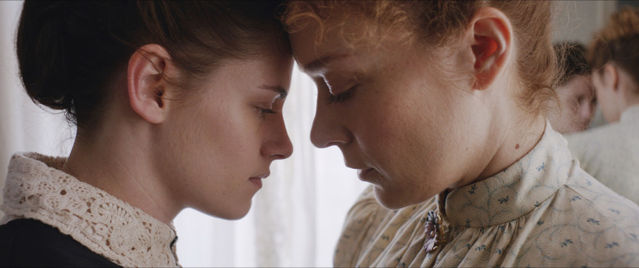In the 125 years since she was accused of murdering her parents, Lizzie Borden has been transformed into a fictionalized fiend, a folk hero, and even a feminist icon. But what is the truth behind this grisly crime? And what makes Borden’s story one we keep returning to?
 Lizzie Andrew Borden (1860-1927), circa 1892
Lizzie Andrew Borden (1860-1927), circa 1892
Everyone knows her name, whether it’s children singing a twisted nursery rhyme or adults recounting the grisly story behind the chant: “Lizzie Borden took an axe/gave her mother 40 whacks/when she saw what she had done/gave her father 41.” Sunday school teacher, daughter, possible murderer of her father and stepmother—Borden is an enigma that we are still obsessing over 125 years later.
Her story has a fairytale quality to it. Not the Disney kind, mind you, but the real death, suffering, and lesson-hidden-in-violence kind. A woman stuck in a house with an overbearing father and an evil stepmother trying to take the family fortune for her own. Suddenly, violence erupts. With the events far in the past, there is enough distance from the gruesome details to allow the curious to be more thrilled than horrified.
For those who may not be aware of the full story, here are the basics. On August 4, 1892, 32-year-old Lizzie Borden discovered the body of her father, Andrew, on a couch in their home in Fall River, MA. He was bleeding profusely from multiple wounds and his face was unrecognizable. Her scream alerted the maid, Bridget, who was taking a nap on the third floor. Bridget immediately ran to get the doctor. When the doctor arrived and saw Andrew’s dead, mutilated body, he alerted the police. Lizzie was in a state of shock, so he gave her some medication to calm her down. About a half hour later, Abby Borden, Lizzie’s stepmother, was discovered upstairs in the guest bedroom. Her body had also been cut to pieces and her head was barely attached to her body. Andrew had been hacked 11 times, while Abby was slashed 18 times. Investigators found Abby’s body to be cold, while Andrew’s was still warm, suggesting that Abby had been killed an hour and a half earlier. Emma, Lizzie’s older sister, was out of town visiting a friend when the murders occurred, and a messenger was sent to deliver the news to her.
 An artist’s depiction of Lizzie Borden fainting as the skulls of her father and stepmother are shown to the jury as evidence.
An artist’s depiction of Lizzie Borden fainting as the skulls of her father and stepmother are shown to the jury as evidence.
These murders shocked Fall River, so much so that a few thousand curious townspeople visited the crime scene during the course of the investigation, unintentionally tampering with evidence. Meanwhile, as law enforcement searched for a motive, they discovered that Andrew had many enemies. He was known as a harsh, stingy man, who had essentially forced his two daughters into spinsterhood by not allowing them to get married. Their home, despite his wealth, didn’t even have basic plumbing and was on the rougher side of town.
The police’s first suspect was a Portuguese laborer who had been seen that day at the Borden home trying to get wages owed to him. Andrew said he had no money and sent him away. Evidence suggested that Abby may have been struck by a tall man, further casting suspicion on the laborer.
Eventually, however, Lizzie became the prime suspect after a local pharmacist told police that she’d tried to buy poison from him the day before the killings. When police questioned Lizzie, she gave contradictory answers and appeared to be confused. She was arrested the next day. More evidence against her came from a family friend, Alice Russell, who told authorities that she’d watched Lizzie burn a blue dress after being questioned. Lizzie claimed that the garment had paint stains on it—it was never determined whether she had been seen in the dress on the day of the murders.
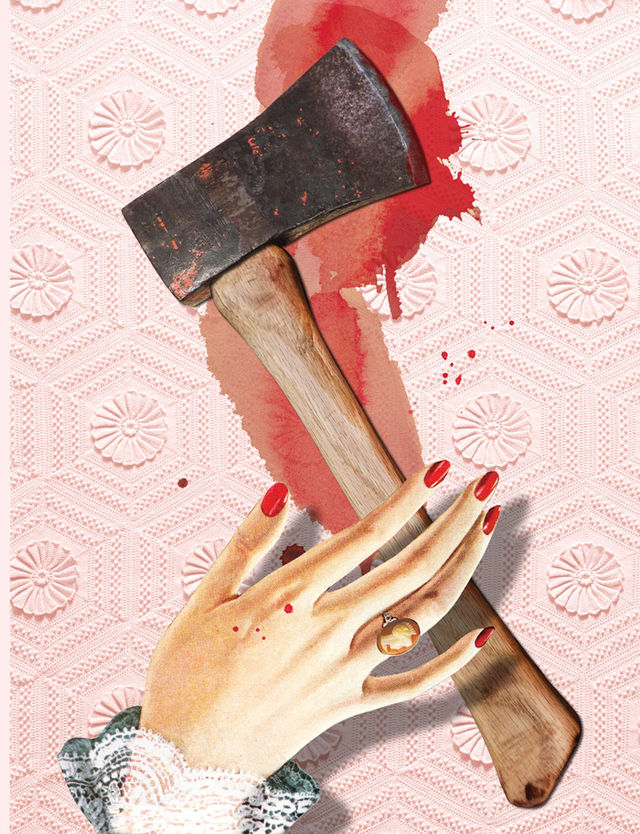 Illustration by Beth Hoeckel
Illustration by Beth Hoeckel
Lizzie’s trial started a year later on June 5, 1893, and it was nothing like anything anyone had ever seen before. The courtroom was filled to the brim with press and spectators. When the prosecution produced the hatchet-mangled skulls of Abby and Andrew right there in the courtroom during a passionate speech, everyone gasped. Lizzie fainted at the sight of the remains and didn’t come to for several minutes. Bridget testified that while Lizzie was at home at the time of the murders, she had not witnessed any hostility between Lizzie and Abby over the two years she was with the family. But according to prosecutors, Lizzie often spoke badly about Abby behind her back. They also brought up that there had been talk of Andrew changing his will, giving everything to Abby and cutting out the Borden sisters.
The defense claimed that not only was Lizzie’s addled testimony not credible due to the morphine that was given to her by the doctor at the scene of the crime, but also that someone who was guilty would not be burning a dress out in the open like Lizzie did. They also brought in two witnesses who reported seeing a strange man near the Borden house the night before the murders. The town doctor corroborated this, saying he also saw a man near the home around the time of the murders. All the evidence against Lizzie was circumstantial and there was not one drop of blood found on her garments. The defense said that she would have had to have been “stark naked” to commit these crimes, which of course was unthinkable for a Victorian woman of virtue. Lizzie also claimed she knew nothing about the will, let alone a change to it.
The jury deliberated for only an hour and half before returning with the verdict of “not guilty.” Both sisters went on to live together in a new home in a richer part of Fall River, but nothing was ever the same. Even though Lizzie was found innocent, the town ostracized the Borden girls and never stopped regarding them with suspicion.
 Body of Andrew Borden
Body of Andrew Borden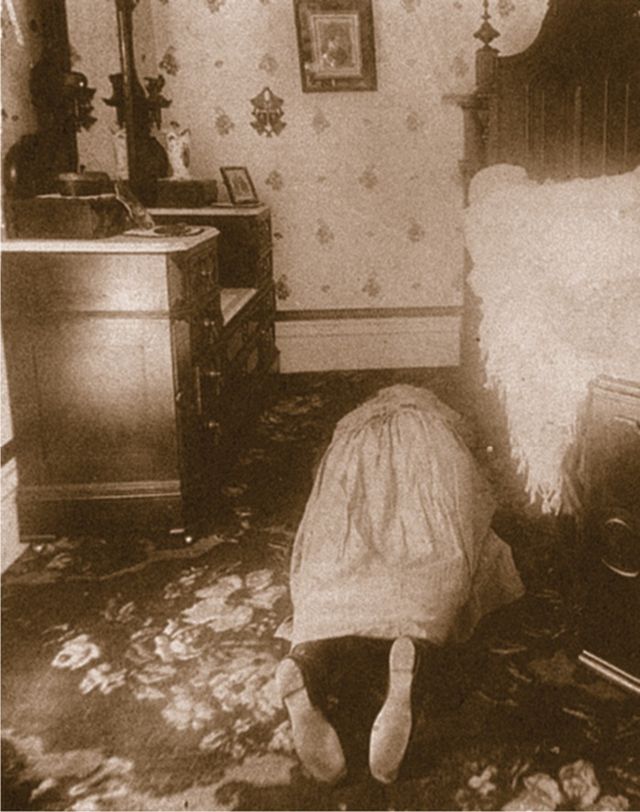 Body of Abby Borden
Body of Abby Borden
Even with so much interest in the case, to this day there is still no consensus on who actually committed this crime. Most believe that Lizzie did it. She did have a motive: she was a 32-year-old woman whose entire life was still being dictated by a father who, by all accounts, was stingy, difficult, and controlling. She also had a lot of resentment toward her stepmother because her father bought a house for Abby’s sister. Once the two were dead, however, Lizzie and Emma would inherit everything and could be free to live however they wished.
But there are others who have different ideas about the killings, and the Borden murders have attracted a coterie of dedicated conspiracy theorists who continue to search for the truth. One example is the Lizzie Borden Society Forum, an online home for detectives of all skill levels to come and discuss the infinite possibilities of this event. Visitors propose ideas, ask for research material, and share their theories.
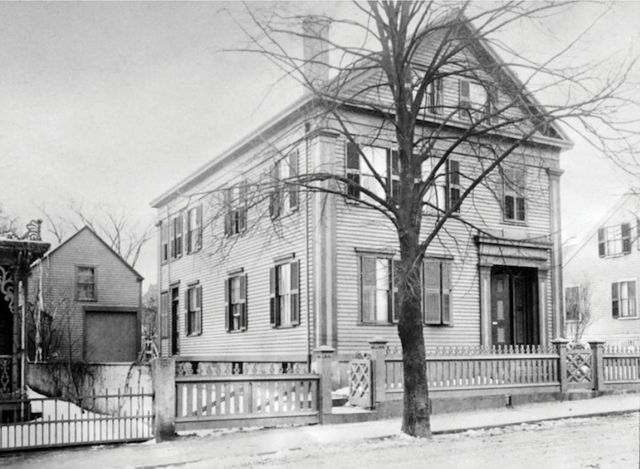 The Borden home in Fall River, MA, around the time of the murders. Today it is a B&B
The Borden home in Fall River, MA, around the time of the murders. Today it is a B&B
Some suspect older sister Emma came home, murdered Andrew and Abby, and then went back to her friend’s home so she’d have the perfect alibi. Emma may have had even more of a motive than Lizzie. After Emma and Lizzie’s mother died, Emma always got short shrift. When she was a teenager, her father pulled her out of school but allowed Lizzie to keep attending, even though she was the weaker student. And in adulthood, Lizzie toured Europe while Emma stayed home. With Andrew and Abby dead, their fortune would be divided between Emma and Lizzie, and the older Borden sister would finally be able to make her own decisions and escape from Lizzie’s shadow.
Another popular theory posits that Lizzie was a lesbian, and in a relationship with the maid, Bridget. In this scenario, the two killed Abby and Andrew so they could be together. Support for this theory is bolstered by Lizzie’s close friendship with an actress named Nance O’Neil that began after the murders. O’Neil was a deep-voiced woman who remained single well into her 40s, while Lizzie never married or had any male suitors. They spent a lot of time together and Lizzie often threw parties for O’Neil. Some even claim O’Neil was the reason why Emma eventually left Maplecroft—the home she shared with Lizzie from 1893 until 1905—and never spoke to her sister again.
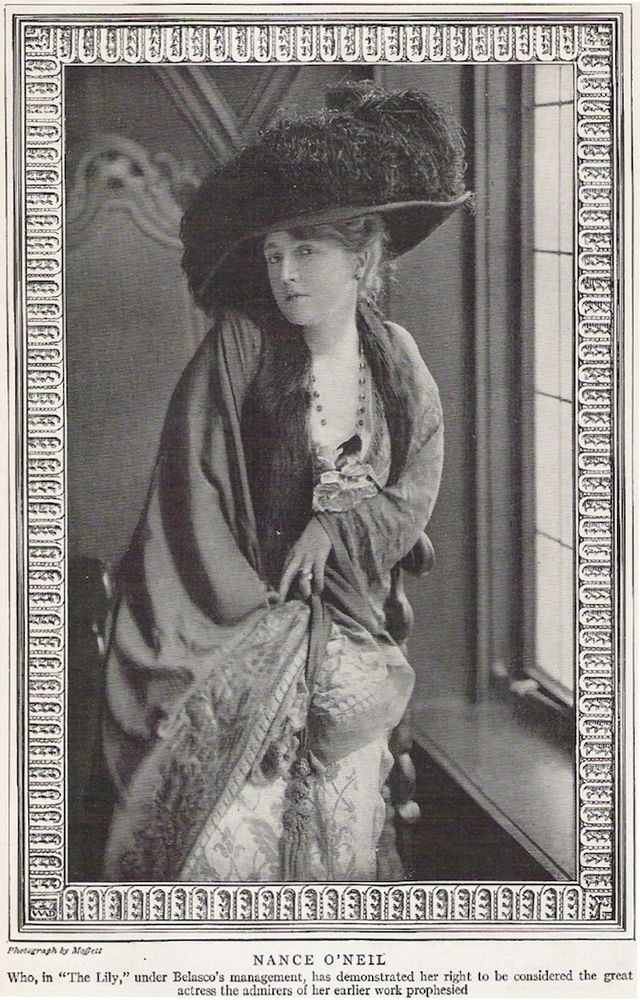 The actress Nance O’Neil. Was she Lizzie’s lover?
The actress Nance O’Neil. Was she Lizzie’s lover?
In another theoretical camp, based on accounts of the peculiar relationship Lizzie had with her father, the murders could have been the violent fallout from incest, though no proof of a sexual relationship between the two has ever been uncovered. Andrew did, however, always very obviously favor Lizzie over Emma. And Lizzie always wanted his attention, burned with jealously whenever he was focused on someone else, and even is said to have been flirtatious toward him. Lizzie also bought Andrew a ring that he always wore and was buried in.
Some propose Lizzie had a split personality disorder, and that one of her other identities took control and committed the murders with Lizzie none the wiser. Those who knew Lizzie remarked that she seemed to jump from one emotion to the next, and at times seemed like a completely different person if things didn’t go her way. This could explain why Andrew was so protective of her.
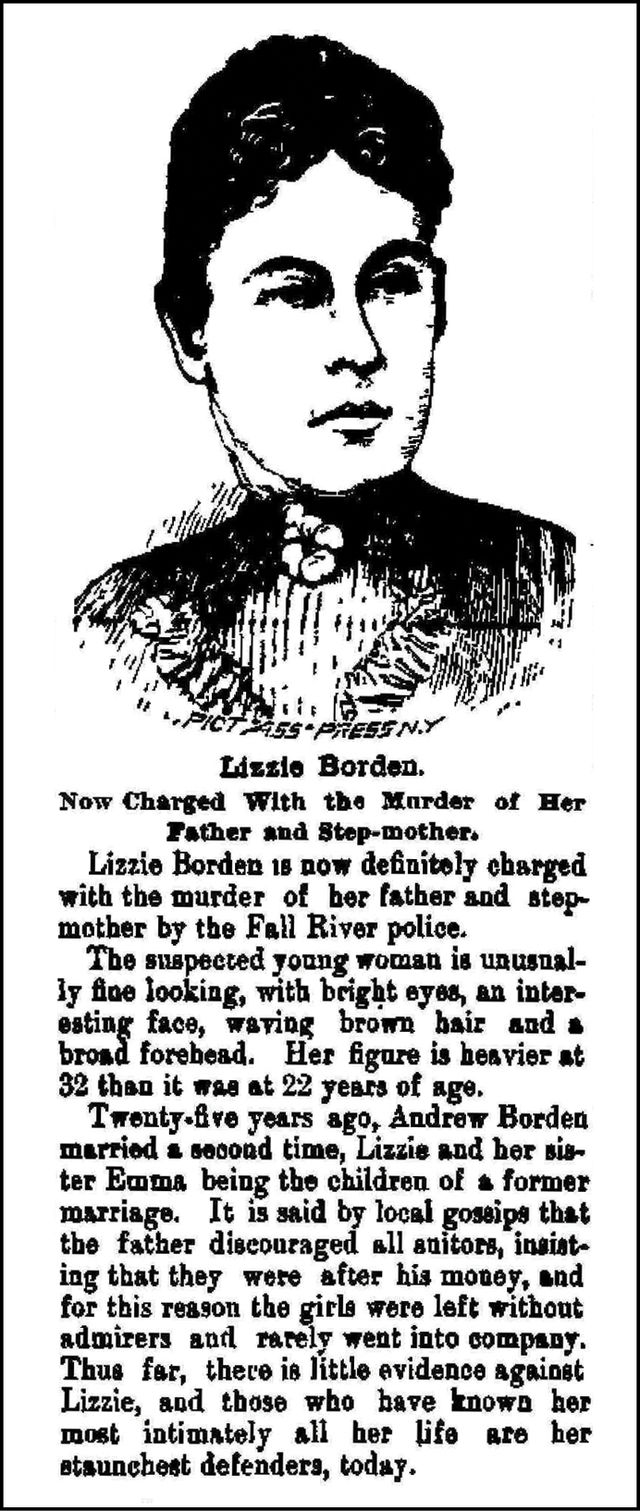 From the Fitchburg Sentinel, Aug. 13, 1892, Fitchburg, MA
From the Fitchburg Sentinel, Aug. 13, 1892, Fitchburg, MA
And then there was the Borden sisters’ maternal uncle, John. Some believed he hired a hit man, possibly to protect his precious nieces. Or maybe he was resentful that Andrew didn’t treat his sister, Andrew’s first wife, right. It also appears that as soon as his first wife died, Andrew cut his daughters off from her side of the family. John wasn’t able to visit very often, and when he did, communication was terse. Andrew and John had been partners in a failing business, and Andrew was known to keep his money close. So if John asked for help, he probably didn’t get it. John was visiting Fall River at the time of the murders, and he was unaccounted for during the time frame of the crime.
But it isn’t just these amateur Nancy Drews who remain obsessed with the tale of Lizzie Borden. The story has also endured as a popular theme in entertainment. There was Agnes de Mille’s 1954 ballet Fall River Legend and the 1965 opera Lizzie Borden, which was recently adapted into a rock opera called Lizzie: The Musical. A 1975 made-for-TV movie called The Legend of Lizzie Borden starred Bewitched’s Elizabeth Montgomery (who in real life was sixth cousins with Lizzie). In 2014, Lifetime aired the Christina Ricci vehicle Lizzie Borden Took an Ax, and followed it up with the series The Lizzie Borden Chronicles. And now, there’s a big screen psychological thriller in the works starring Chloë Sevigny as Lizzie and Kristen Stewart as Bridget the maid.
But why does fascination with this particular unsolved mystery persist so many years later? One possibility is that Lizzie’s trial was one of the first in U.S. history fueled by mass-market newspapers and magazines. Publications coast-to-coast reported on the trial every day. And when there weren’t enough courtroom details to fill the columns, writers would focus on Lizzie’s face, as if that might betray some sign of her innocence or guilt. “The prisoner sat behind the Deputy Sheriff and listened to [District Attorney] Moody’s careful address with the closest attention, as calm and unmoved as ever,” reported The New York Times on June 6, 1893. “Her eyes looked straight toward the speaker. Indeed, the spectators seemed as much interested in the prosecutor’s words as did Miss Borden, and but for the uniformed Sheriff sitting beside her she might have been taken by a stranger for one of those who had come to the courtroom with no greater interest than that of curiosity.”
Another reason the Borden case became so huge at the time, and possibly why it still intrigues us, is that the victims and the accused killer were all wealthy. The case showed that high society wasn’t all it was cracked up to be. And Lizzie’s arrest punctured a class-based façade while creating a subtle social shift. Before the murders, the fact that Andrew kept both of his adult daughters under his thumb was not considered questionable. But in the wake of his death, his behavior was seen as a possible precursor to unspeakable violence. By contrast, after her acquittal, Lizzie became emblematic of the independent woman—especially when she never married and lived in a fancy home until her death in 1927 at age 66. Both she and the murder rocked the status quo, and nobody will ever forget it.
One more important factor when considering the longevity of Lizzie Borden’s appeal is the way in which her case so clearly hinged on society’s expectations of women at the time. The trial was held at the height of the Victorian era, an age of idealized womanhood that emphasized femininity, family, and respectability. In fact, the cornerstone of Lizzie’s defense was that there was no way a genteel woman of her affluent background could commit such a horrible crime. That means if Lizzie did do it, she turned the patriarchy on its head and used sexist assumptions to get away with murder. And if she didn’t do it, she stood up for herself and won. Maybe women just appreciate the fact that the Lizzie Borden case implies that women can, in fact, be evil. Either way, 125 years after the crimes, Lizzie is now often regarded as a feminist icon.
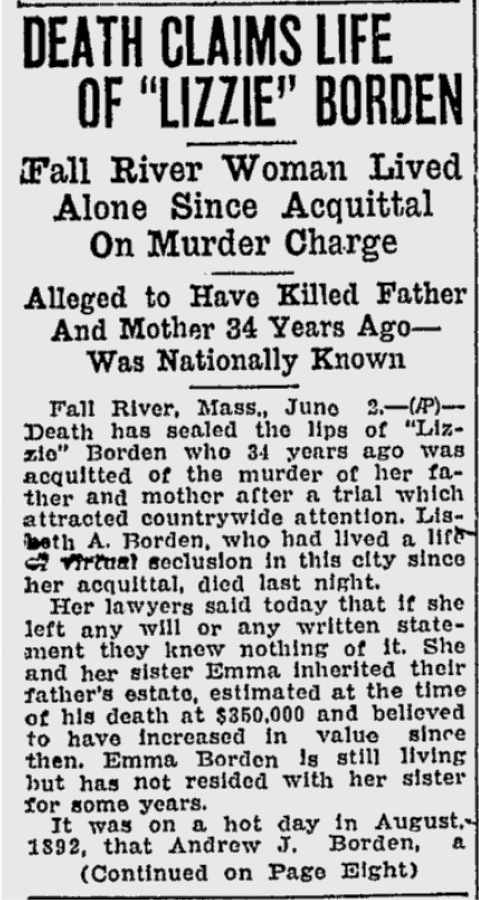 Lizzie Borden dies, as reported on June 1, 1927, by the Lewiston Daily Sun, Lewiston, ME
Lizzie Borden dies, as reported on June 1, 1927, by the Lewiston Daily Sun, Lewiston, ME
Lizzie’s story continues to evolve as more about her is uncovered, like the discovery of her attorney’s journal, a document that indicates both bodies were moved before crime scene photos were taken and that Abby “was running to get away from the [murderer], away from the door, as if she had run around the bed as far as she could,” indicating the assailant may have been a stranger. Maplecroft, the mansion where Lizzie lived out her post-trial life, was recently restored and is now being pitched to interested buyers as a potential bed and breakfast currently operating in the home where the murders took place. And Lizzie’s meatloaf recipe was unearthed by the Fall River Historical Society 16 years ago (it contains beef, pork, egg, onion, soda crackers, herbs, salt, and pepper). But for true Lizzie Borden fanatics, no amount of uncovering will be enough. Every year on the anniversary of Andrew and Abby Borden’s deaths, thousands of true crime fans descend upon the city of Fall River. Maybe we will never know what happened that hot August day in 1892. Maybe we will never know who is the real culprit. Maybe we will never stop asking questions. But one thing is for sure: Lizzie Borden will never be forgotten.
By Erynn Porter
This article originally appeared in the December/January 2017 print edition of BUST Magazine. Subscribe today!
top photo: Lizzie (2018)
More from BUST
In The Victorian Era, Babies Wore (Sometimse Deadly) Veils
The Comic “Lady Killers” Shows A Woman Murdering Sexual Harassers — And It Comes At The Perfect Time

